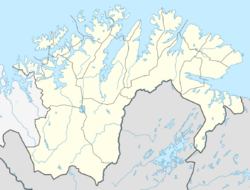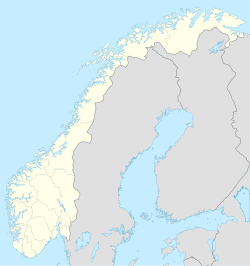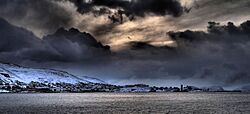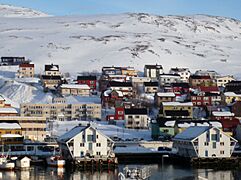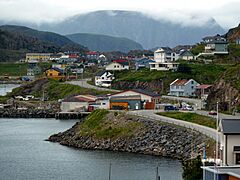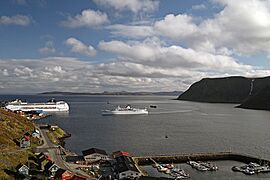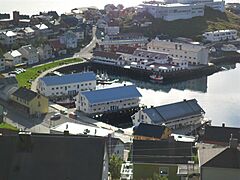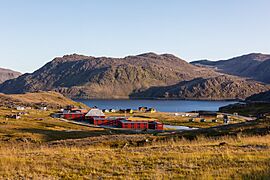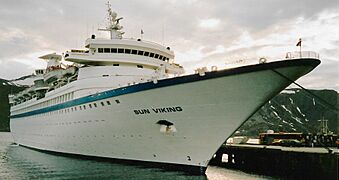Honningsvåg facts for kids
Quick facts for kids
|
|
|---|---|
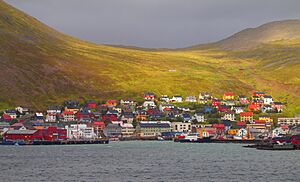
View of the city
|
|
| Country | Norway |
| Region | Northern Norway |
| County | Finnmark |
| District | Vest-Finnmark |
| Municipality | Nordkapp Municipality |
| Established as | |
| Town (By) | 1996 |
| Area | |
| • Total | 1.04 km2 (0.40 sq mi) |
| Elevation | 12 m (39 ft) |
| Population
(2023)
|
|
| • Total | 2,245 |
| • Density | 2,159/km2 (5,590/sq mi) |
| Demonym(s) | Honningsvåging |
| Time zone | UTC+01:00 (CET) |
| • Summer (DST) | UTC+02:00 (CEST) |
| Post Code |
9750 Honningsvåg
|
Honningsvåg is a small but important city in Norway. It is known for being the northernmost city on the mainland of Norway. Honningsvåg is located in the Nordkapp Municipality in Finnmark county.
Even though it's small, Honningsvåg was declared a city in 1996. It covers about 1 square kilometer (0.4 square miles) and has a population of 2,245 people (as of 2023). This means it has a lot of people living close together for its size!
The city sits in a bay on the large island of Magerøya. The famous North Cape, a popular tourist spot, is on the northern side of this island. Honningsvåg is a busy port for ships like the Hurtigruten Coastal Express and many cruise ships, especially during summer.
The ocean around Honningsvåg stays ice-free. This is great for fishing, which is a big part of the city's economy. Tourism is also very important. Even though it's far north, some gardens in Honningsvåg have trees, though they are usually not very tall.
A famous dog named Bamse came from Honningsvåg. He was a St. Bernard who became a hero during World War II.
Contents
Getting Around Honningsvåg
Honningsvåg is a key stop for the Hurtigruten coastal ships. These ships travel a long route along the Norwegian coast. They go between Kirkenes in the north and Bergen in the south.
Northbound ships arrive in the morning and stay for a few hours. This brings many tourists to the city. Southbound ships stop briefly early in the morning.
The Honningsvåg Airport is about 4 kilometers (2.5 miles) north of the city. It offers flights mainly to Tromsø. From Tromsø, you can connect to flights to Oslo. There is also a bus line that connects Honningsvåg to Alta.
Honningsvåg's Past
People first settled in this area a very long time ago, about 10,300 years ago! They likely got most of their food from the sea.
Becoming a City
Honningsvåg was officially named a city in 1996 by the local government of Nordkapp. A law was passed in Norway in 1997 saying that cities must have at least 5,000 people. But since Honningsvåg became a city before this law, it was allowed to keep its city status. This makes it one of the smallest cities in Norway.
What's in a Name?
The name Honningsvåg comes from an old farm name, Honningsvaag. The first part of the name might come from an old name for a nearby mountain called Storefjell (meaning "big mountain"). This mountain has a peak that looks like a horn. The last part, vágr, means "inlet" or "bay". So, the full name means "the bay lying beneath the mountain that looks like a horn."
Honningsvåg's Climate
Even though Honningsvåg is very far north in Europe, it doesn't have an extremely cold polar climate. This is thanks to the North Atlantic Drift. This ocean current brings warmer water from the south. Because of this, winters are quite mild for such a northern place. They are even milder than winters in Oslo, which is much further south!
However, Honningsvåg is on the coast, so it can have strong winter storms and blizzards. Sometimes, roads might even close because of the weather. Snow can be very deep in winter, and there can be a risk of avalanches in steep areas. Rain and snow fall pretty evenly throughout the year, but there's a bit more in autumn.
Honningsvåg experiences a "polar day" with the midnight sun from May 13 to July 31. This means the sun never sets during this time! From November 21 to January 21, the sun stays below the horizon. This is called the "polar night." The hottest temperature ever recorded in Honningsvåg was 28.4°C (83.1°F) on June 29, 2022.
| Climate data for Nordkapp, 1991–2020 normals, extremes 2002–present | |||||||||||||
|---|---|---|---|---|---|---|---|---|---|---|---|---|---|
| Month | Jan | Feb | Mar | Apr | May | Jun | Jul | Aug | Sep | Oct | Nov | Dec | Year |
| Record high °C (°F) | 6.8 (44.2) |
7.8 (46.0) |
8.3 (46.9) |
12.5 (54.5) |
20.1 (68.2) |
28.4 (83.1) |
27.1 (80.8) |
24.8 (76.6) |
21 (70) |
13.3 (55.9) |
9.2 (48.6) |
8.6 (47.5) |
28.4 (83.1) |
| Mean maximum °C (°F) | 4.9 (40.8) |
4.9 (40.8) |
4.9 (40.8) |
7.8 (46.0) |
13.7 (56.7) |
17.7 (63.9) |
22.6 (72.7) |
20.2 (68.4) |
15.7 (60.3) |
10.5 (50.9) |
7.1 (44.8) |
6.2 (43.2) |
22.9 (73.2) |
| Mean daily maximum °C (°F) | −0.5 (31.1) |
−1.0 (30.2) |
0.4 (32.7) |
3.0 (37.4) |
6.8 (44.2) |
9.6 (49.3) |
13.4 (56.1) |
12.7 (54.9) |
10.2 (50.4) |
5.6 (42.1) |
2.8 (37.0) |
1.4 (34.5) |
5.4 (41.7) |
| Daily mean °C (°F) | −2.5 (27.5) |
−3.3 (26.1) |
−1.7 (28.9) |
0.7 (33.3) |
4.2 (39.6) |
6.9 (44.4) |
10.2 (50.4) |
10.2 (50.4) |
8.0 (46.4) |
3.8 (38.8) |
0.7 (33.3) |
−0.8 (30.6) |
3.0 (37.4) |
| Mean daily minimum °C (°F) | −4.8 (23.4) |
−5.2 (22.6) |
−3.4 (25.9) |
−0.9 (30.4) |
2.6 (36.7) |
5.5 (41.9) |
8.6 (47.5) |
8.6 (47.5) |
6.5 (43.7) |
2.3 (36.1) |
−0.9 (30.4) |
−2.7 (27.1) |
1.3 (34.3) |
| Mean minimum °C (°F) | −10.7 (12.7) |
−10.6 (12.9) |
−8.5 (16.7) |
−6.0 (21.2) |
−1.5 (29.3) |
1.5 (34.7) |
5.3 (41.5) |
5.0 (41.0) |
2.6 (36.7) |
−2.8 (27.0) |
−5.6 (21.9) |
−8.3 (17.1) |
−12.5 (9.5) |
| Record low °C (°F) | −15.3 (4.5) |
−17.2 (1.0) |
−11.0 (12.2) |
−10.0 (14.0) |
−5.7 (21.7) |
0.0 (32.0) |
0.0 (32.0) |
1.0 (33.8) |
0.0 (32.0) |
−5.6 (21.9) |
−11.3 (11.7) |
−21.2 (−6.2) |
−21.2 (−6.2) |
| Average precipitation mm (inches) | 55 (2.2) |
39 (1.5) |
51 (2.0) |
36 (1.4) |
42 (1.7) |
46 (1.8) |
48 (1.9) |
52 (2.0) |
64 (2.5) |
78 (3.1) |
50 (2.0) |
63 (2.5) |
627 (24.7) |
| Average extreme snow depth cm (inches) | 61 (24) |
60 (24) |
59 (23) |
64 (25) |
32 (13) |
0 (0) |
0 (0) |
0 (0) |
1 (0.4) |
31 (12) |
31 (12) |
32 (13) |
75 (30) |
| Average precipitation days (≥ 1.0 mm) | 9 | 7 | 10 | 8 | 7 | 7 | 7 | 6 | 7 | 10 | 7 | 8 | 94 |
| Average relative humidity (%) | 78 | 78 | 76 | 75 | 72 | 77 | 79 | 79 | 78 | 79 | 79 | 78 | 77 |
| Average dew point °C (°F) | −6.0 (21.2) |
−6.6 (20.1) |
−5.4 (22.3) |
−2.9 (26.8) |
0.2 (32.4) |
3.5 (38.3) |
7.1 (44.8) |
6.8 (44.2) |
4.9 (40.8) |
0.7 (33.3) |
−2.2 (28.0) |
−3.9 (25.0) |
−0.3 (31.5) |
| Source 1: Norwegian Meteorological Institute | |||||||||||||
| Source 2: yr.no /Norwegian Meteorological Institute | |||||||||||||
Image Gallery
Notable People
See also
 In Spanish: Honningsvåg para niños
In Spanish: Honningsvåg para niños


